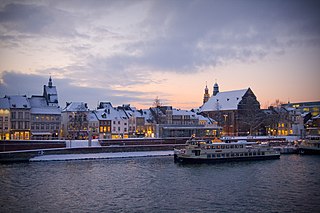
Maastricht is a city and a municipality in the southeastern Netherlands. It is the capital and largest city of the province of Limburg. Maastricht is located on both sides of the Meuse, at the point where the Jeker joins it. Mount Saint Peter (Sint-Pietersberg) is largely situated within the city's municipal borders. Maastricht is adjacent to the border with Belgium and is part of the Meuse-Rhine Euroregion, an international metropolis with a population of about 3.9 million, which includes the nearby German and Belgian cities of Aachen, Liège, and Hasselt.
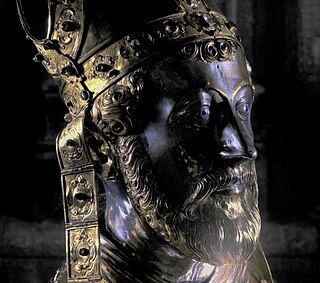
Saint Servatius was bishop of Tongeren. Servatius is patron saint of the city of Maastricht and the towns of Schijndel and Grimbergen. He is one of the Ice Saints. His feast day is May 13.
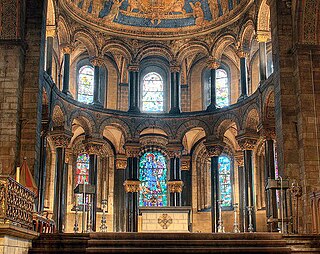
Mosan art is a regional style of art from the valley of the Meuse in present-day Belgium, the Netherlands, and Germany. Although in a broader sense the term applies to art from this region from all periods, it generally refers to Romanesque art, with Mosan Romanesque architecture, stone carving, metalwork, enamelling and manuscript illumination reaching a high level of development during the 11th, 12th and 13th centuries.

Fulham Railway Bridge crosses the River Thames in London. It is very close to Putney Bridge, and carries the London Underground District line between Putney Bridge station on the North, and East Putney station on the South. Fulham Railway Bridge can also be crossed on foot, on the downstream (east) side.

The Arrigoni Bridge, also known locally as the Portland Bridge is a steel through arch bridge carrying Route 17 and Route 66 across the Connecticut River, connecting Middletown, Connecticut, to Portland, Connecticut. When it opened in 1938, the 1,200 feet (370 m) bridge was the most expensive bridge ever built in Connecticut, at a cost of $3.5 million. Its two distinctive 600 feet (180 m) steel arches have the longest span length of any bridge in the state. The bridge has an average daily traffic of 33,600.
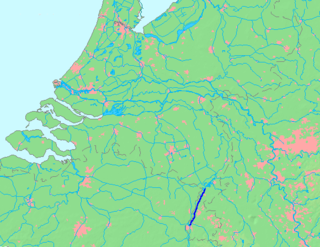
The Juliana Canal, named after Queen Juliana of the Netherlands, is a 36 km long canal in the southern Netherlands, providing a bypass of an unnavigable section of the river Meuse between Maastricht and Maasbracht. It is an important transport connection between the ports of the Rhine delta and the industrial areas of southern Limburg and southern Belgium.

The Basilica of Saint Servatius is a Roman Catholic church dedicated to Saint Servatius, in the center of Maastricht, Netherlands. The architecturally hybrid but mainly Romanesque church is situated next to the Gothic Church of Saint John, backing onto the town's main square, Vrijthof.

The Pont del Diable, also known as Sant Bartomeu Bridge, is a medieval bridge crossing the river Llobregat and straddling the municipalities of Martorell and Castellbisbal in Catalonia, Spain. The bridge is restricted to pedestrians.
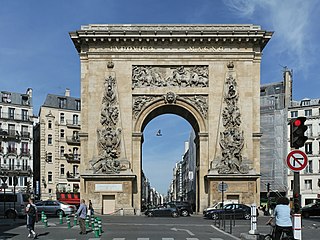
The Porte Saint-Denis is a Parisian monument located in the 10th arrondissement, at the site of one of the gates of the Wall of Charles V, one of Paris' former city walls. It is located at the crossing of the Rue Saint-Denis continued by the Rue du Faubourg Saint-Denis, with the Boulevard de Bonne-Nouvelle and the Boulevard Saint-Denis.
South Limburg is both a COROP (statistical) region as well as a landstreek (area) of the Netherlands located in the province of Limburg. The Dutch term landstreek, literally translated "land area/region", means that the area is not an administrative region but an area that displays cohesion with regard to culture and landscape. With regards to South Limburg this deals with its hilly landscape, especially in the Heuvelland region, sunken lanes, an abundance of castles, and the regional language Limburgish spoken by a significant part of the population alongside Dutch. The region also contains the highest point above sea level in mainland Netherlands, the Vaalserberg being 322.5 metres (1,058 ft) above sea level.

François Romain, also known by his Flemish name Francis Rooman or his latinised name Franciscus Romanus, was an engineer-architect who was professed as a lay brother Dominican friar. By commission of the States General of the Netherlands, in 1683 he reconstructed parts of the ancient St. Servatius Bridge at Maastricht, crossing the river Meuse in nine arches. Successful in this undertaking, for which dredging was required, he was requested to come to Paris, where he resided in the monastery of Saint-Thomas-d'Aquin, and oversaw the completion of the Pont Royal, which had been designed by Jules Hardouin-Mansart, with a central arch having a span of 23.5 meters. Record of payments to him beginning 1 April 1685, three weeks after the contract was awarded, showed that, contrary to the traditional account that he was not brought in until trouble had been encountered, he was the specialist in the project from the beginning. Dredging the Seine's riverbed was required in order to establish sound footings, and caissons were employed for the deep foundations here for the first time, half a century before Charles Labélye's use of them at Westminster Bridge, London. Construction proceeded without incident and was completed and the bridge formally opened, 13–14 June 1689. This further success procured him the office of inspector of bridges and embankments in Paris.

The Treasury of the Basilica of Saint Servatius is a museum of religious art and artifacts inside the Basilica of Saint Servatius in Maastricht, Netherlands.
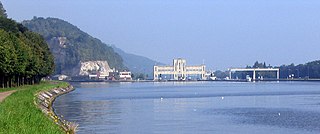
Mount Saint Peter, also referred to as Caestert Plateau, is the northern part of a plateau running north to south between the valleys of the river Geer to the west, and the Meuse to the east. The plateau runs from Maastricht in the Netherlands, through Riemst in Belgian Limburg almost to the city of Liège in Belgium, thus defining the topography of this border area between Flanders, Wallonia and the Netherlands. The name of the hill, as well as the nearby village and church of Sint Pieter and the fortress of Sint Pieter, refers to Saint Peter, one of the Twelve Apostles.
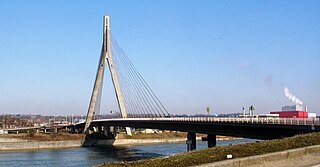
The Pont de Wandre is a single-pier cable-stayed bridge carrying the N667 road across the Albert Canal and the river Meuse between Liège and Herstal, both in Belgium.

Binnenstad is a neighbourhood in Maastricht, Netherlands. Until 2007, it was officially named City. As its name suggests, it is the most centrally located area of Maastricht.

Ponte Vella is a medieval footbridge built on Roman foundations in Ourense, Spain. Located at the intersection of N120 and Rua Progreso, it spans the Minho River. Its steep rise of 135 feet (41 m) above the Minho River makes for safe passage during flash floods. At one time, it was considered to be the biggest bridge in all of Spain.
The following is a timeline of the history of the municipality of Maastricht, Netherlands.
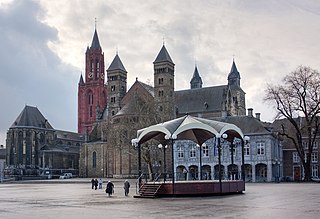
Vrijthof is a large urban square in the centre of Maastricht, Netherlands. The square developed from an ancient Roman and Frankish cemetery into a semi-private space that belonged to the Collegiate Church of Saint Servatius. In the 19th century, it became the town's main square. It is surrounded by important heritage buildings, museums, a theatre, and a range of hotels, restaurants, and bars. The square is regularly used for public events.

The Pilgrimage of the Relics or Maastricht Septennial Pilgrimage is a seven-yearly Catholic event in the Dutch city of Maastricht. Originating in the Middle Ages, it developed from a pilgrimage to the grave of Saint Servatius into the present-day religious, historical, cultural and commercial enterprise. Highlights in the programme are the displaying or unveiling of the relics in the main churches and secondly, the processions with the town's main relics. The next pilgrimage will take place in 2025.

The Sint-Janskerk is a Gothic church in the center of Maastricht, Netherlands. The Protestant Sint-Jan is situated next to the Roman Catholic Basilica of Saint Servatius on the town's main square, Vrijthof.























